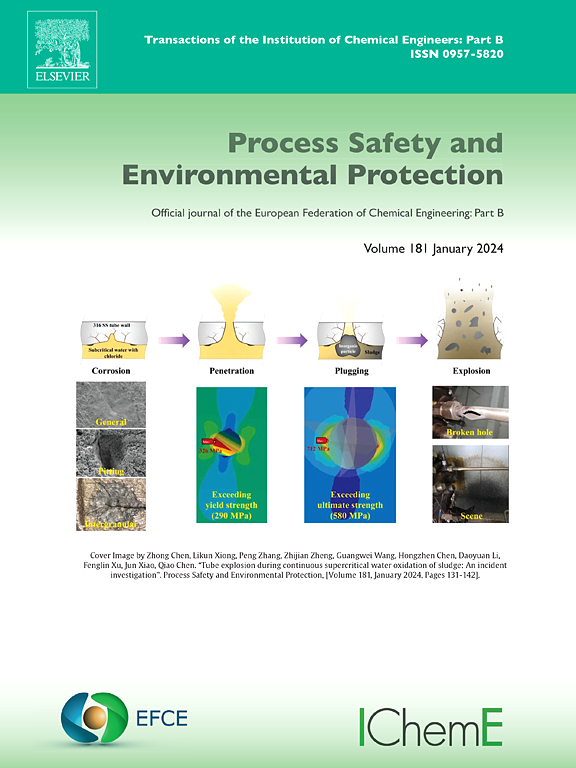安全阀排气压力对大规格磷酸铁锂电池热失控影响的实验研究
IF 7.8
2区 环境科学与生态学
Q1 ENGINEERING, CHEMICAL
引用次数: 0
摘要
大规格磷酸铁锂(LFP)电池的热失控(TR)已成为一个关键的技术问题,因为它可能导致广泛的火灾事故。安全阀(SV)起着重要的作用,它使电池内部产生的气体迅速释放,从而延迟TR (TTR)的发生。然而,安全阀的初始设定排气压力(Psv)对锂离子电池(lib)的TR行为的影响以及相关危害的严重程度仍不清楚。为了解决这个问题,本研究调查了不同Psv的LFP电池在热滥用条件下的TR行为和相关风险。结果表明,无SV的LFP电池在TR过程中发生燃烧,危险性显著增加。随着Psv的增大,升温过程中最高温度(Tmax)和峰值升温速率(dT/ dT)max逐渐减小。最后,采用TR评价模型对不同Psv下LFP电池的危害进行了评价。无SV的电池的TR危害最高,而Psv为0.35 MPa的电池的TR危害最低。然而,更高的Psv会导致电池内部峰值压力的积累,从而增加严重安全事故的风险。因此,选择合适的Psv需要仔细考虑电池的操作规范和安全标准,以达到最佳平衡。通过比较不同Psv条件下电池的响应,可以为电池的设计和安全性评估提供更全面的理论和实验依据。本文章由计算机程序翻译,如有差异,请以英文原文为准。
Experimental study on the impact of safety valve venting pressure on thermal runaway in large-format lithium iron phosphate battery
Thermal runaway (TR) of large-format lithium iron phosphate (LFP) batteries has become a critical technical issue due to its potential to cause extensive fire incidents. The safety valve (SV) plays an important role that it enables gases generated inside the battery to release promptly, thereby delaying the onset of TR (TTR). However, the impact of the initial setting venting pressure of the safety valve (Psv) on the TR behavior of lithium-ion batteries (LIBs) and the severity of the associated hazards remain unclear. To address this, this study investigates the TR behavior and associated risks of LFP batteries with different Psv under thermal abuse conditions. The results indicate that LFP batteries without SV experience combustion during TR, significantly increasing the hazard. With increasing Psv, the maximum temperature (Tmax) and peak rate of temperature rise (dT/dt)max during TR decrease gradually. Finally, a TR assessment model is employed to evaluate the hazards of LFP batteries under different Psv. Batteries without SV exhibit the highest TR hazards, whereas those with the Psv of 0.35 MPa demonstrated the lowest hazards. However, higher Psv results in the accumulation of higher peak pressures inside the battery, thereby increasing the risk of severe safety incidents. Therefore, the selection of the appropriate Psv requires careful consideration of the battery's operational specifications and safety standards to achieve an optimal balance. This results can provide a more comprehensive theoretical and experimental basis for battery design and safety assessment by comparing battery responses under different Psv conditions.
求助全文
通过发布文献求助,成功后即可免费获取论文全文。
去求助
来源期刊

Process Safety and Environmental Protection
环境科学-工程:化工
CiteScore
11.40
自引率
15.40%
发文量
929
审稿时长
8.0 months
期刊介绍:
The Process Safety and Environmental Protection (PSEP) journal is a leading international publication that focuses on the publication of high-quality, original research papers in the field of engineering, specifically those related to the safety of industrial processes and environmental protection. The journal encourages submissions that present new developments in safety and environmental aspects, particularly those that show how research findings can be applied in process engineering design and practice.
PSEP is particularly interested in research that brings fresh perspectives to established engineering principles, identifies unsolved problems, or suggests directions for future research. The journal also values contributions that push the boundaries of traditional engineering and welcomes multidisciplinary papers.
PSEP's articles are abstracted and indexed by a range of databases and services, which helps to ensure that the journal's research is accessible and recognized in the academic and professional communities. These databases include ANTE, Chemical Abstracts, Chemical Hazards in Industry, Current Contents, Elsevier Engineering Information database, Pascal Francis, Web of Science, Scopus, Engineering Information Database EnCompass LIT (Elsevier), and INSPEC. This wide coverage facilitates the dissemination of the journal's content to a global audience interested in process safety and environmental engineering.
 求助内容:
求助内容: 应助结果提醒方式:
应助结果提醒方式:


